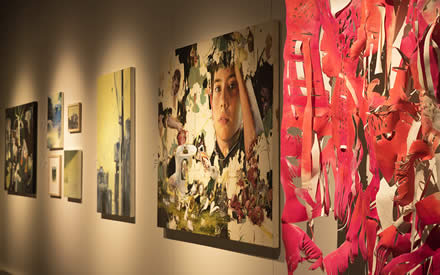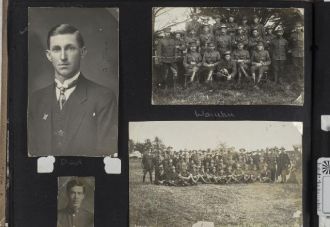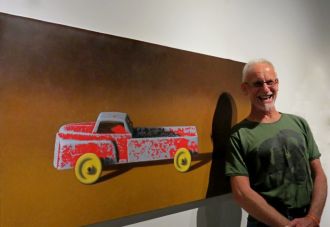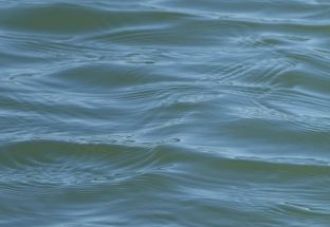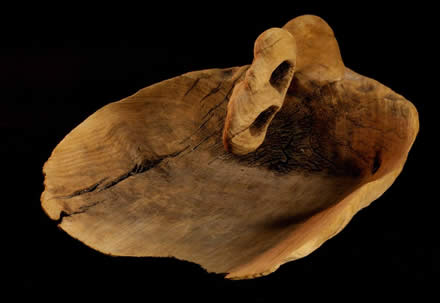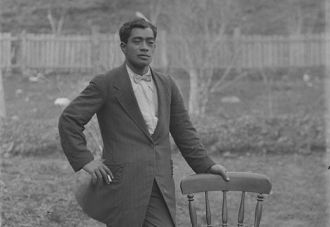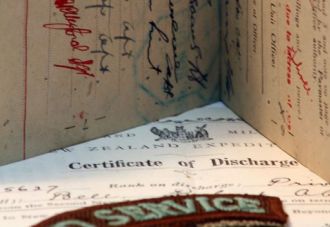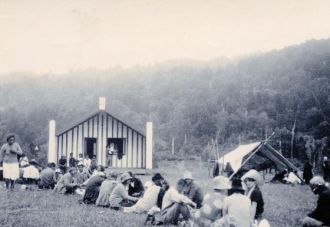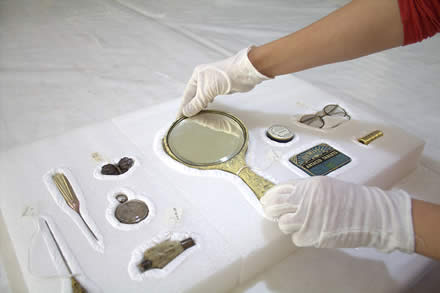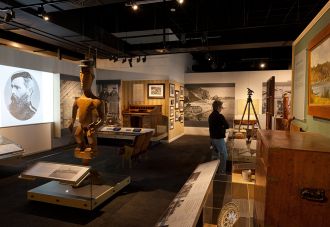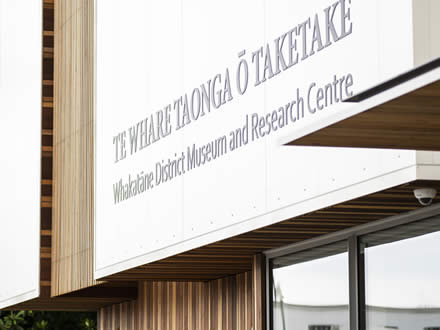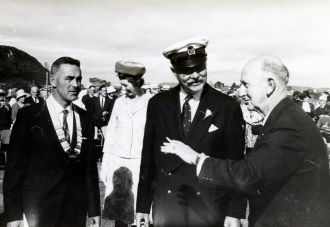Date:

Presented by Whakatāne Museum and Arts, The Molly Morpeth Canaday 3D Award has been established to encourage and recognise the quality of creativity found in the area of three-dimensional applied arts, including sculpture.
These awards have been made possible through the generous support of the Molly Morpeth Canaday Trust, established by Frank Canaday in memory of his wife, Molly Morpeth Canaday. The trust has been a major supporter of the arts in Whakatāne for over 25 years, and Whakatāne Museum and Arts would like to extend our thanks for the trust’s continuing support.
For the first time, the Art Award will be exhibited across all three galleries at Te Kōputu a te whanga a Toi – the Whakatane Library and Exhibition Centre.
The winners of the major $5,000 award provided by the Molly Morpeth Canaday Trust and the new Whakatāne Society of Arts and Crafts - Local Artist Award of $250 were announced by the judge, Kim Paton, at the opening night Friday, 5 August.
2016 winners
Molly Morpeth Canaday Major Award $2500
 Floyd Perry
Floyd Perry
Cedar, Tasmanian oak, kwila, fibreglass, epoxy
Craftsmanship and working with one’s hands has become outdated and overlooked in this era of mass-produced objects. My practice aims to promote a retrospective awareness of the importance of making, and the inevitable loss of skills in the era of industrial reproduction. The canoe strives to draw attention to the labour involved in the making of objects that is frequently taken for granted. The craftsman and the canoe can present a challenge to the ethics of consumerism, protesting against the readymade objects so widely distributed in today’s culture. The canoe acts as a vessel for an intuition to slow down and give greater regard to the humility of the hand crafted.
Judge's comments
In many ways Porter is a work that is easy to understand. To look at it is to understand what it is and what it is made of. We can see in its material form the layers of the timber that have been rendered by hand and the simple, meticulous detail of the boat’s exposed joinery. Porter speaks to the heart of the making process. It demonstrates a commitment to time, and labour, to learning an applied skill situated within a craft tradition and trusting in an outcome that lies far ahead. On land Porter sits idle, an object imbued with potential of the water and the poetic and unknown nature of a journey yet to come.
Molly Morpeth Canaday Major Award $2500
 Jasmine Te Hira
Jasmine Te Hira
The Beauty of Invisible Grief
Digital video
The Beauty of Invisible Grief derives from a translated experience of dislocation, detachment, recognition of site, space and experiential knowledge embedded in concepts drawn between the ‘cultural artefact’ and identity.
Collected samples of disembodied water were frozen in the form of a traditional
which when worn as a body adornment piece, its documentation of loss is recorded by both the wearer and digitally. In the acknowledgment of site, the bodies of water included in this piece are collected from three individual rivers I whakapapa to.
The 42-minute video portrait documents the experience of its matter and through the loss of its materiality including the pearl and silver riveted eyes, in close proximity to the warmth of the body, the process of grief and loss is both activated and lifted,mirroring personal social archaeologies and accumulated memories. Layered audio recordings included also acknowledge descending from other locations simultaneously.
Digital technologies as a framing device have also allowed for the platform to debate, where historical knowledge sets are currently stored — in developing memory banks, altering relationships between new access points to knowledge, oral lineages and customary behaviours. As a work, it seeks to challenge the perceptions surrounding institutionally stored taonga, the paradoxical environments of value exchange and access to material information.
 Judge's comments
Judge's comments
As an object, how might we understand The Beauty of Invisible Grief. A video plays of a traditional heir tiki form, rendered in ice and melting in real time adorning the body. Te Hira collected water from each of the three rivers of her whakapapa, casting it in this jewellery form; we hear a soft, sweet song momentarily, a calling by the artist to the land and location of her whanau, her ancestry that she is simultaneously distant from and connected to. The video plays on an immaculate and highly recognisable Mac screen – a symbol of contemporary culture, design and communication. Te Hira encases the screen in a glass vitrine and ornate timber side table; these too are familiar, reminding us of colonial museological mechanisms for display in which Taonga and artefact are presented out of context, separated from the situation in which their meaning and significance were made.
Whakatāne Society of Arts and Crafts Local Art Award
Tangimoe Clay
No More Plastic Bags
Harakeke
With the growing concerns of the pollution caused by plastic carry bags to our environment, I continue to make, use and promote a sustainable and biodegradable hard wearing kete mahi (working basket) handed down from our forefathers.
Judge's comments
Tangimoe Clay’s five kete mahi are built for work, used in daily life for whatever purpose might be required; their purpose is functional and utilitarian, and yet they possess a masterful demonstration of an age old making tradition passed down to Clay from her forefathers. In the beauty of the simple harakeke weave, we see evidence of craft and skill and a reverence for their object form, and importantly we also see the keeping and maintaining of culture through a making practice. Clay’s approach articulates an adversity to wastefulness and a sensitivity to protecting material resources that underscore the enduring significance of craft-based practices.
2016 finalists
- Anna-Rose Carpenter
- Adrienne Ranson
- Ainsley O'Connell
- Andrew Simmonds
- Kirsty Gardiner
- Caitlin Devoy
- Campbell Kneale
- Dominic Burrell
- Dasul Lee
- Floyd Perry
- Frances Rood
- Fran Carter
- Glen Hayward
- Jacquelyn Greenbank
- Jasmine Te Hira
- Janna van Hasselt
- John Roy
- Lynda Wilson
- Layla Walter
- Madeleine Child
- Mary Curtis
- Matt Akehurst
- Melissa McMahon
- Mia Straka
- Natalie Guy
- Nik Hanton
- Oliver Roake
- Paul Cullen
- Philip Jarvis
- Rachel Bell
- Roger Kelly
- Tangimoe Clay
- Tim Larkin
- V + I Edwards + Johann
- Virginia Leonard
2016 Judge
The Molly Morpeth Canaday 3D Award was judged by the director of Auckland’s Objectspace, Kim Paton.
Kim Paton is a highly-regarded artist and art academic whose recent work, The Free Store Project, was included in the 29th Biennial of Graphic Arts in Ljubljana, Slovenia. Formerly the Research Leader and Lecturer at Wintec’s School of Media Arts, she took up the role of Director at Objectspace in 2015.
Ms Paton also holds a first class honours degree in sculpture from Massey University in Wellington and says she is looking forward to her task of evaluating the diverse entries of the Molly Morpeth Canaday 3D Art Award.
2016 sponsors







